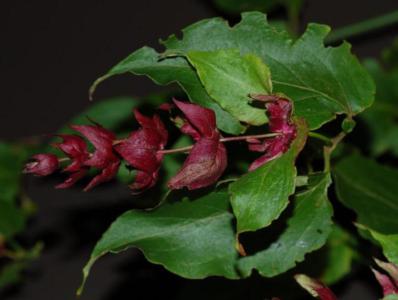Leycesteria
(Leycesteria)

Description
Leycesteria, commonly known as Himalayan honeysuckle, is a genus of flowering shrubs in the Caprifoliaceae family. This genus contains around six species of deciduous shrubs that are native to the Himalayas, China, and Taiwan. They are known for their distinctive pendent, tubular flowers, and glossy fruit that matures to a dark purplish-black color. Leycesteria plants are commonly grown in gardens for their ornamental value and are also known for their medicinal properties. Etymology: The genus name, Leycesteria, was given in honor of William Leycester, a British doctor and botanist who lived during the 17th century. The common name, Himalayan honeysuckle, refers to the fact that the plant is native to the Himalayan region and produces flowers that resemble those of the honeysuckle plant. Taxonomy: Leycesteria is a genus in the Caprifoliaceae family, which includes other popular garden plants such as honeysuckles and viburnums. The genus was first described in 1825 by the English botanist John Lindley. There are six recognized species of Leycesteria, including: Leycesteria formosa: This species is native to the Himalayas and China and is the most commonly cultivated species. It has striking pendent clusters of purple-red bracts that surround the flowers and are followed by glossy purple-black berries. Leycesteria crocothyrsos: This species is native to China and has distinctive yellow flowers. Leycesteria gracilis: This species is native to Taiwan and has slender branches and white flowers. Leycesteria hypoleuca: This species is native to Japan and has white flowers. Leycesteria pallidiflora: This species is native to China and has pink flowers. Leycesteria stipulata: This species is native to the Himalayas and has white flowers. Description: Leycesteria plants are deciduous shrubs that typically grow to a height of 6-10 feet (1.8-3 m) and a spread of 4-6 feet (1.2-1.8 m). They have an upright habit and produce arching stems that are covered in lush green leaves that are up to 7 inches (18 cm) long. The leaves are arranged oppositely along the stem and have toothed edges. The flowers of Leycesteria plants are tubular and pendent, and they are produced in clusters at the tips of the stems. The flowers are surrounded by bracts that are usually brightly colored, which add to their ornamental value. The bracts persist after the flowers have faded, providing interest well into the fall. Leycesteria plants are dioecious, meaning that there are separate male and female plants, and both are needed to produce fruit. The fruit of Leycesteria plants is a small, glossy berry that matures to a dark purplish-black color. The berries are edible and have a sweet, slightly tart flavor. They are often used in jams and other culinary preparations. Cultivation: Leycesteria plants are easy to grow and are well-suited to a wide range of garden conditions. They prefer moist, well-drained soil and full to partial sun. Leycesteria plants are hardy in USDA zones 6-9 and can withstand temperatures down to -10°F (-23°C). Propagation of Leycesteria plants is typically done by softwood cuttings taken in late spring or early summer. Seeds can also be sown in the fall or spring
Taxonomic tree:







